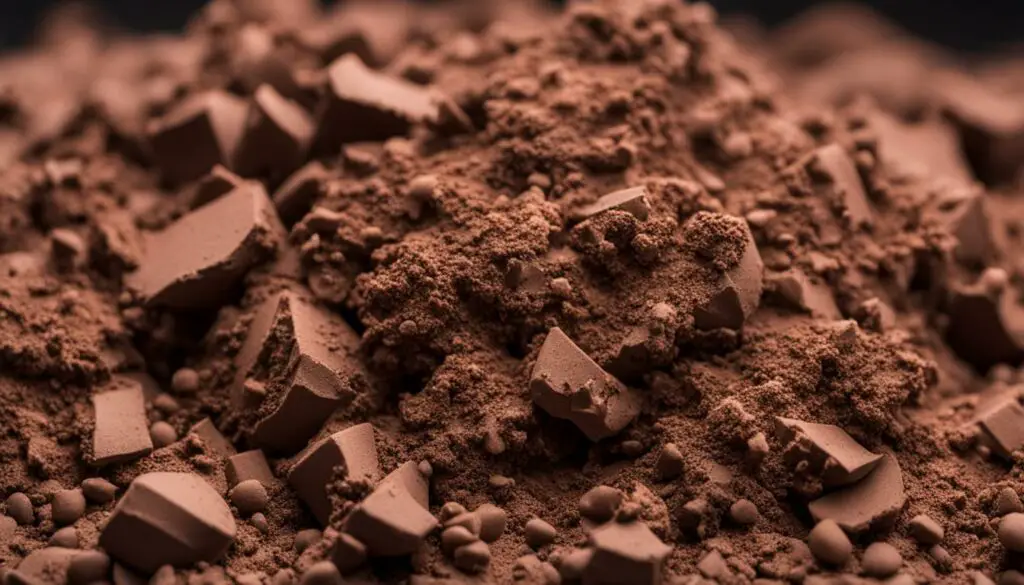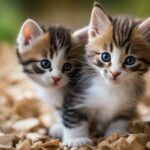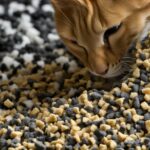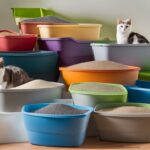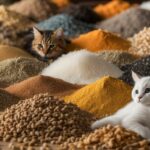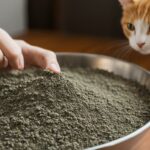Welcome to my comprehensive exploration of the topic: “Is Clay Litter Bad For Cats?” As a cat lover and advocate for feline health, I understand the importance of finding the best litter option for our beloved companions. In this article, we will delve into the pros and cons of clay litter, considering both the potential health risks and environmental impact. By the end of this exploration, you will have a thorough understanding of why clay litter may not be the optimal choice for your feline friend.
Key Takeaways:
- Clay litter can be prone to tracking, dusty, and heavy.
- It contains crystalline silica dust, a known carcinogen when inhaled.
- The harvesting process of clay litter is not environmentally friendly.
- Consider the potential health risks and environmental impact before using clay litter.
Pros of Non-Clumping Clay Litter
Non-clumping clay litter has several advantages that make it a popular choice among cat owners. One of the main benefits is its affordability, making it a budget-friendly option for those on a tight budget. Additionally, non-clumping clay litter is readily available in most pet stores, making it easily accessible for cat owners.
Another advantage of non-clumping clay litter is that it requires less scooping compared to other types of litter. This can save time and effort for cat owners, allowing them to spend more quality time with their furry friends. However, it is important to note that non-clumping clay litter does not absorb liquid as effectively as clumping clay litter.
Despite its benefits, non-clumping clay litter does have some drawbacks. It can be dusty, leading to potential respiratory issues for both cats and humans. Additionally, it is easily tracked, which means that it can create a mess around the litter box area. Non-clumping clay litter also offers mediocre odor control, which may not be ideal for households with multiple cats.
| Pros | Cons |
|---|---|
| Affordable | Dusty |
| Readily available | Easily tracked |
| Requires less scooping | Mediocre odor control |
| Heavy | |
| Not eco-friendly | |
| Not biodegradable | |
| Contains carcinogenic silica dust |
Cons of Non-Clumping Clay Litter
While non-clumping clay litter has its advantages, it also comes with several disadvantages that cat owners should consider. Here are the cons of using non-clumping clay litter:
- Affordable and readily available: Non-clumping clay litter is often more affordable and easily accessible compared to other types of cat litter. However, its affordability comes at a cost.
- Less scooping: Non-clumping clay litter requires less scooping compared to other litter types because it doesn’t form clumps. While this may seem convenient, it also means that cat owners will need to change the litter more frequently to maintain cleanliness.
- Dusty and easily tracked: Non-clumping clay litter tends to be dusty, which can be irritating to both cats and humans. Additionally, it is easily tracked outside the litter box, creating more mess and requiring more cleaning.
- Mediocre odor control: While non-clumping clay litter absorbs some odors, it often provides only mediocre odor control compared to other litter options.
- Heavy: Non-clumping clay litter is heavier than other types of litter, making it more difficult to handle and dispose of.
- Not eco-friendly and not biodegradable: One of the biggest drawbacks of non-clumping clay litter is its negative impact on the environment. It is not biodegradable and contributes to landfill waste.
- Contains carcinogenic silica dust: Perhaps the most concerning disadvantage of non-clumping clay litter is its composition. It contains crystalline silica dust, a known carcinogen when inhaled by both cats and humans.
Considering these cons, it is important for cat owners to weigh the convenience and affordability of non-clumping clay litter against the potential health risks and environmental impact.
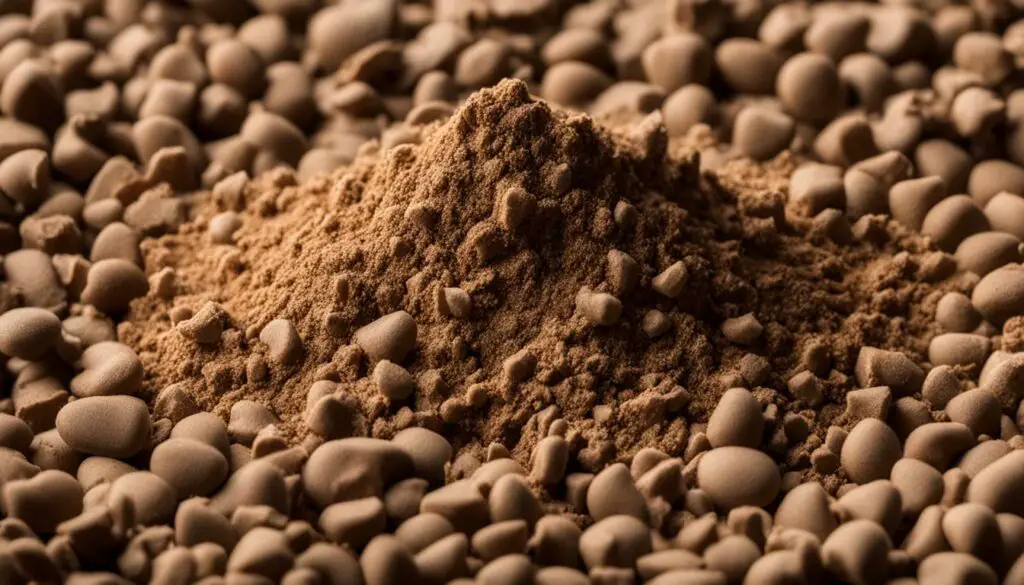
Reference Table – A Comparison of Litter Options
| Litter Type | Advantages | Disadvantages |
|---|---|---|
| Non-Clumping Clay Litter | – Affordable and readily available – Requires less scooping – Absorbs some odors |
– Dusty and easily tracked – Mediocre odor control – Heavy – Not eco-friendly and not biodegradable – Contains carcinogenic silica dust |
| Tofu Cat Litter | – Eco-friendly and biodegradable – Flushable – Long-lasting odor control – Dust-free and low tracking |
– Higher price – Vulnerable to spoilage if not stored properly |
Pros of Clumping Clay Litter
Clumping clay litter offers several benefits that make it a popular choice among cat owners. Here are the key advantages:
- Easier to clean: Clumping clay litter forms small clumps when it comes into contact with liquid waste, making it easier to scoop out and clean the litter box.
- Better odor control: The clumping action of this litter helps to encapsulate and trap unpleasant odors, keeping your home smelling fresh and clean.
- Longer lasting: Clumping clay litter tends to last longer compared to non-clumping varieties. The clumps can be easily removed, allowing the remaining litter to stay fresher for a longer period of time.
However, it’s worth noting that clumping clay litter also has some downsides. It can be dusty, leading to potential respiratory issues for both cats and humans. The dust can also create a mess around the litter box, as it can be easily tracked throughout the house. Additionally, clumping clay litter is not environmentally friendly, as it is heavy, non-biodegradable, and contains carcinogenic silica dust. Therefore, it’s important to weigh the pros and cons before choosing clumping clay litter for your feline friend.
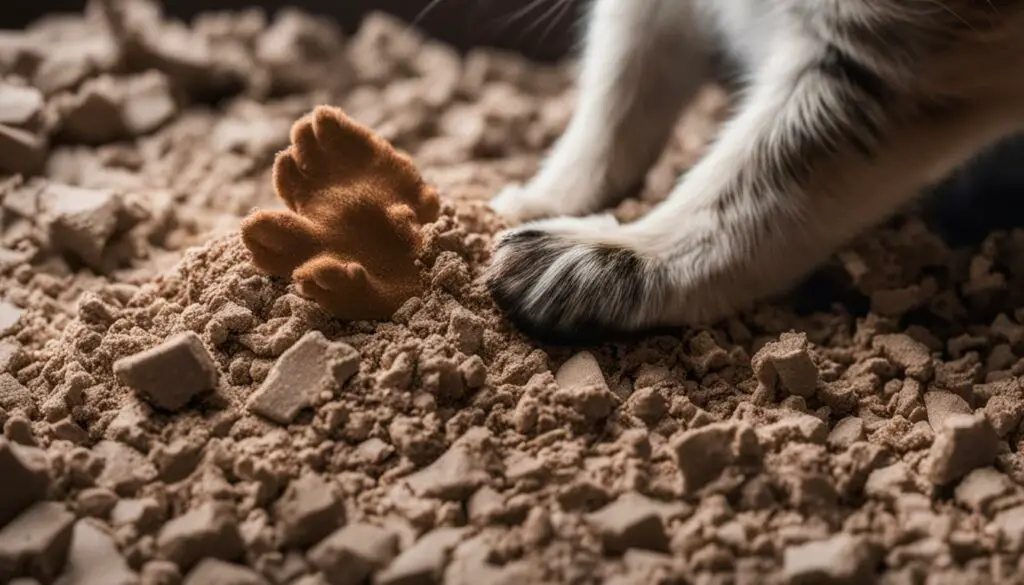
Cons of Clumping Clay Litter
Clumping clay litter, despite its advantages, also has its fair share of disadvantages. While it is easier to clean and offers better odor control compared to non-clumping litter, there are several drawbacks to consider.
Firstly, clumping clay litter tends to be dusty, which can be problematic for both cats and their owners, especially those with respiratory issues. The fine dust particles can be easily inhaled, posing a risk to respiratory health. Additionally, the dust can settle on surfaces around the litter box, creating a mess that needs to be frequently cleaned.
Another downside of clumping clay litter is that it is easily tracked. Cats can inadvertently carry the litter on their paws and spread it throughout the house, resulting in an additional cleaning chore for pet owners. Moreover, clumping clay litter is not eco-friendly. It is heavy and does not biodegrade, contributing to landfill waste. The production and mining of clay litter also have a negative impact on the environment.
Perhaps the most concerning disadvantage of clumping clay litter is its content of carcinogenic silica dust. When the litter is disturbed, whether by scooping or by the cat digging in the box, tiny particles of silica dust can become airborne. Inhaling this dust can pose a risk to both cats and humans, potentially leading to respiratory issues and long-term health problems. Therefore, it is crucial to handle clumping clay litter with caution and consider alternative options for the safety of your cat and yourself.
| Cons of Clumping Clay Litter | |
|---|---|
| Dustiness | Clumping clay litter can be dusty, leading to potential respiratory issues for cats and humans. |
| Tracking | The litter is easily tracked by cats, resulting in a mess throughout the house. |
| Environmental Impact | Clumping clay litter is not eco-friendly as it is non-biodegradable and contributes to landfill waste. |
| Silica Dust | The litter contains carcinogenic silica dust, which can be harmful when inhaled. |
Pros of Tofu Cat Litter
Tofu cat litter offers numerous benefits that make it a great choice for cat owners who prioritize eco-friendliness, biodegradability, and convenience. Here are the key pros of using tofu cat litter:
- Eco-friendly: Tofu cat litter is made from natural materials and is environmentally friendly. It is typically produced from soybean residue, which is a byproduct of the tofu manufacturing process. Choosing tofu litter helps reduce the demand for clay mining, which is detrimental to the environment.
- Biodegradable: One of the significant advantages of tofu cat litter is its biodegradability. When disposed of, it will break down naturally over time, unlike traditional clay litter that can persist in landfills for years.
- Flushable: Tofu cat litter is often designed to be flushable, which makes it easy to dispose of waste. Simply scoop the clumps into the toilet and flush them away, minimizing the amount of litter that ends up in the trash.
- Long-lasting: Tofu cat litter has excellent absorbency, which allows it to last longer compared to some other litter types. This means you’ll need to replace the litter box less frequently, saving you time and money in the long run.
- Dust-free: Unlike clay litter, which can produce a lot of dust when poured or disturbed, tofu cat litter is virtually dust-free. This is beneficial for both cats and their owners, as it reduces the risk of respiratory irritation and keeps the surrounding area cleaner.
- Low tracking: Tofu cat litter tends to have minimal tracking, meaning your furry friend is less likely to leave a trail of litter throughout your home. This can make cleaning up after your cat a much easier task.
- Clumping: Tofu cat litter often clumps together when it comes into contact with liquid waste, making it easy to scoop out and maintain a clean litter box. The clumping action helps to contain odors and simplifies the process of litter box maintenance.
- Non-toxic: Tofu cat litter is non-toxic, making it safe for both cats and humans. This is especially important if your cat has a tendency to ingest small amounts of litter while grooming.
- Lightweight: Tofu cat litter is generally lighter in weight compared to clay litter. This makes it easier to handle and fill the litter box, particularly for individuals with physical limitations or multiple litter boxes to maintain.
- Higher price: While tofu cat litter offers numerous benefits, it is typically priced higher than traditional clay litter. However, many cat owners find the additional cost worth it for the advantages it provides.
- Vulnerable to spoilage: Tofu cat litter can be vulnerable to spoilage if not stored properly. It is important to keep it in a cool, dry location and ensure the packaging is tightly sealed to maintain freshness.
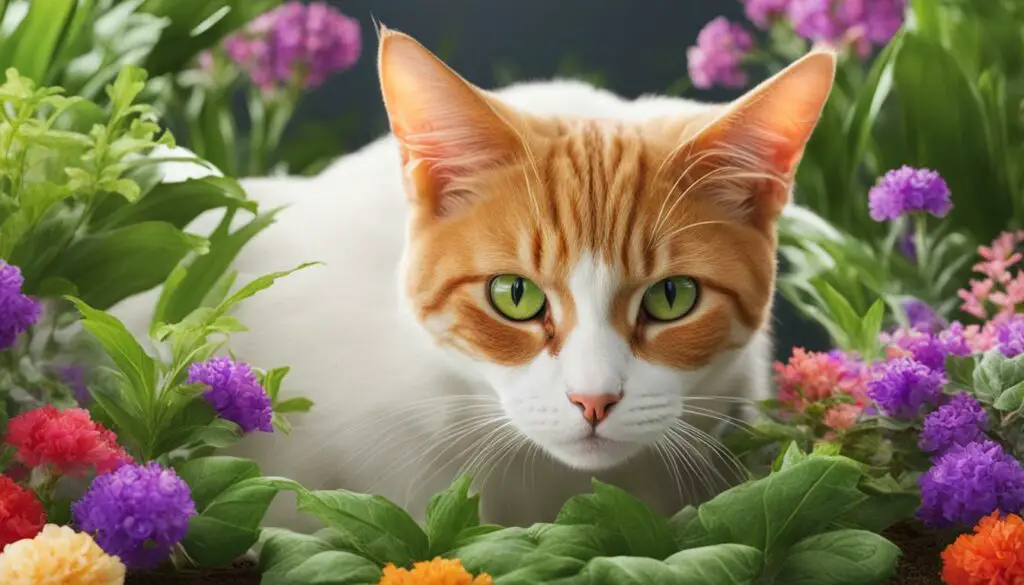
Table: Comparison of Tofu Cat Litter with Other Litter Types
| Litter Type | Eco-friendly | Biodegradable | Flushable | Long-lasting | Dust-free | Low Tracking | Clumping | Non-toxic | Lightweight | Higher Price | Vulnerable to Spoilage |
|---|---|---|---|---|---|---|---|---|---|---|---|
| Tofu Cat Litter | ✓ | ✓ | ✓ | ✓ | ✓ | ✓ | ✓ | ✓ | ✓ | ✓ | ✓ |
| Clay Litter | X | X | X | X | ✓ | X | ✓ | X | X | ✓ | X |
| Crystal Litter | X | X | X | X | ✓ | ✓ | X | ✓ | ✓ | ✓ | X |
| Paper Pellet Litter | ✓ | ✓ | X | X | ✓ | ✓ | X | ✓ | ✓ | ✓ | X |
| Walnut Litter | ✓ | ✓ | X | X | ✓ | ✓ | ✓ | ✓ | ✓ | ✓ | ✓ |
| Pine Pellet Litter | ✓ | ✓ | ✓ | X | ✓ | ✓ | X | ✓ | ✓ | ✓ | X |
| Corn Litter | ✓ | ✓ | ✓ | X | ✓ | ✓ | X | ✓ | ✓ | ✓ | ✓ |
Table: Comparison of Tofu Cat Litter with Other Litter Types. The table showcases the key characteristics and features of different litter types, allowing for a comprehensive comparison.
Cons of Tofu Cat Litter
While tofu cat litter offers numerous benefits, it also has its downsides. It is important to consider these cons when deciding if tofu litter is the right choice for your cat.
One of the main disadvantages of tofu cat litter is its higher price compared to other options. Tofu litter is a premium product that provides excellent performance, but it may come with a slightly higher price tag. However, many cat owners find that the benefits outweigh the cost.
Another potential drawback of tofu litter is that it can be vulnerable to spoilage if not stored properly. Tofu litter is made from organic materials, which means it can break down if it gets wet or is exposed to moisture for an extended period. It is essential to store tofu litter in a dry environment to maintain its quality.
Lastly, some cats may not prefer the texture or scent of tofu cat litter. Cats can be picky about their litter, and it may take some time for them to adjust to tofu litter if they are used to a different type. However, with patience and positive reinforcement, most cats can make the switch successfully.
| Cons of Tofu Cat Litter |
|---|
| Higher price compared to other options |
| Vulnerable to spoilage if not stored properly |
| Some cats may not prefer the texture or scent of tofu litter |
“Tofu cat litter is a premium product that provides excellent performance, but it may come with a slightly higher price tag.”
Overall, despite these cons, tofu cat litter remains a safe and environmentally friendly option for cat owners. Its eco-friendly and biodegradable nature, along with its flushable and long-lasting qualities, make it an attractive choice. While the higher price and potential spoilage may deter some, many cat owners find that the benefits of tofu litter outweigh these disadvantages. It’s worth considering if you are looking for a litter option that prioritizes your cat’s health and the environment.
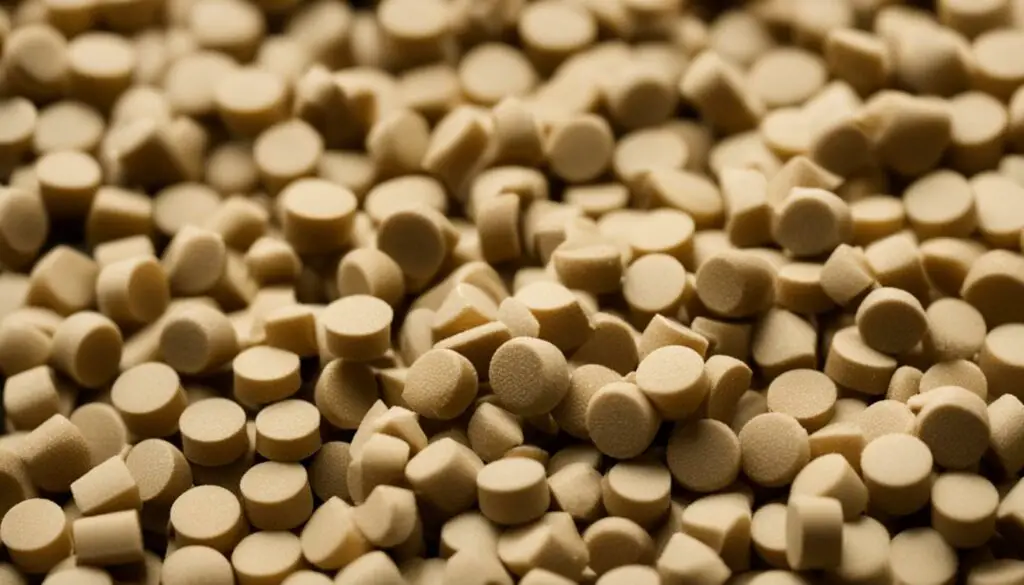
Pros of Crystal (Silica Gel) Cat Litter
Crystal cat litter, also known as silica gel litter, offers numerous benefits for cat owners seeking a high-quality litter option. One of its main advantages is its low dust formulation, which creates a cleaner and healthier environment for both cats and their owners. The lightweight nature of crystal litter makes it easy to handle and pour, reducing the strain on your wrists and back during litter box maintenance.
In addition to its dust-free properties, crystal cat litter provides excellent odor control. The silica gel absorbs and traps moisture, effectively neutralizing unpleasant smells and keeping your home smelling fresh. This feature is particularly beneficial for cat owners who are concerned about litter box odors permeating their living spaces.
Crystal litter also promotes a hygienic litter box. Its moisture-absorbing properties prevent the growth of bacteria and mold, minimizing the risk of infections and maintaining a clean environment for your cat. Furthermore, crystal litter requires low maintenance as it does not clump, making it easier to scoop and clean the litter box on a regular basis.
Despite its many advantages, it’s important to note that crystal cat litter has some potential drawbacks. The lightweight nature of the litter makes it more prone to tracking, which means it can be scattered outside the litter box more easily. Some cats may find the texture of crystal litter uncomfortable on their paws, potentially leading to litter box aversion. Additionally, crystal litter is not biodegradable and not eco-friendly. It is important to dispose of used crystal litter responsibly and consider the environmental impact of this type of litter.
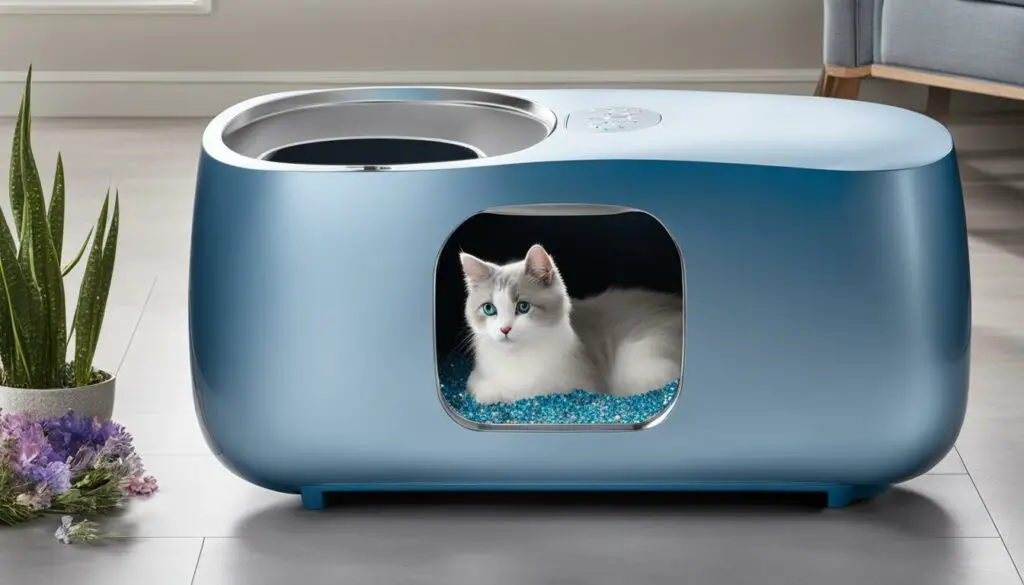
| Pros of Crystal (Silica Gel) Cat Litter |
|---|
| Low dust formulation |
| Lightweight and easy to handle |
| Great odor control |
| Hygienic litter box |
| Low maintenance |
| Non-toxic |
| May be easily tracked |
| Uncomfortable texture for some cats |
| Non-clumping |
| Not eco-friendly or biodegradable |
| Expensive compared to other options |
Pros of Paper Pellet Cat Litter
When considering a cat litter option that is both eco-friendly and affordable, paper pellet cat litter emerges as a top choice. This type of litter offers several benefits that make it a popular option among cat owners:
- Eco-friendly: Paper pellet cat litter is made from recycled newspapers, making it an environmentally conscious choice. It reduces waste and promotes sustainability.
- Unscented and non-toxic: Paper litter is free from added scents and chemicals, ensuring the health and well-being of your cat. It provides a safe and natural litter option.
- Biodegradable: Unlike traditional clay litters, paper pellet litter is biodegradable. It breaks down naturally over time, reducing its impact on the environment.
- Low tracking and low dust: Paper pellets are larger in size compared to other litters, resulting in minimal tracking outside the litter box. It also produces less dust, keeping your home clean and free from respiratory irritants.
- Affordable: Paper pellet cat litter is budget-friendly and provides excellent value for money. It offers high absorbency, reducing the frequency of litter box changes.
- Mediocre odor control: While paper pellet litter provides decent odor control, it may not be as effective as other litter types. Regular maintenance and timely litter box cleaning can help mitigate any potential odor concerns.
- Uncomfortable texture: Some cats may take time to adjust to the texture of paper pellet litter. It is advisable to introduce the litter gradually and monitor your cat’s comfort level during the transition.
- Non-clumping: Paper pellet litter does not clump like clay or tofu litters. While this may require more frequent changing, it eliminates the need for scooping out clumps.
- Hard to clean and requires frequent changing: Due to its non-clumping nature, paper pellet litter can be slightly challenging to clean. It may require more frequent litter box changes to maintain cleanliness.
Table: Comparison of Cat Litter Types
| Litter Type | Eco-Friendly | Odor Control | Tracking | Clumping | Price | Texture | Changing Frequency |
|---|---|---|---|---|---|---|---|
| Paper Pellet Cat Litter | Yes | Mediocre | Low | No | Affordable | Uncomfortable | Frequent |
| Clumping Clay Cat Litter | No | Good | Medium | Yes | Variable | Neutral | Less frequent |
| Tofu Cat Litter | Yes | Excellent | Low | Yes | Premium | Soft | Less frequent |
As shown in the table, paper pellet cat litter offers an eco-friendly and affordable alternative to other litter types. While it may have some drawbacks such as moderate odor control, uncomfortable texture, and frequent changing requirements, these can be managed with proper litter box maintenance and monitoring. Overall, paper pellet cat litter is a viable choice for cat owners who prioritize sustainability and cost-effectiveness without compromising on their cat’s comfort and well-being.
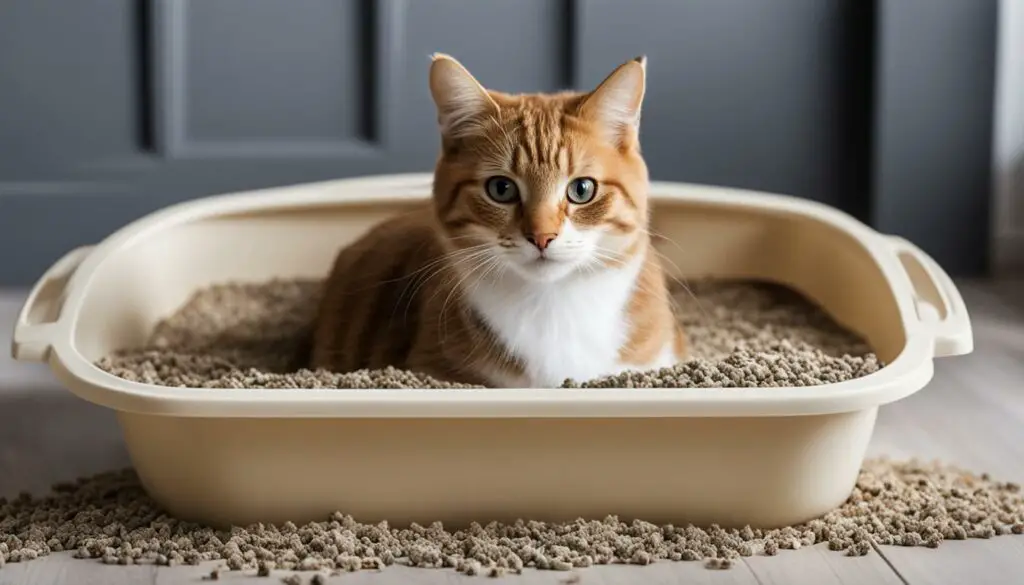
Pros of Walnut Cat Litter
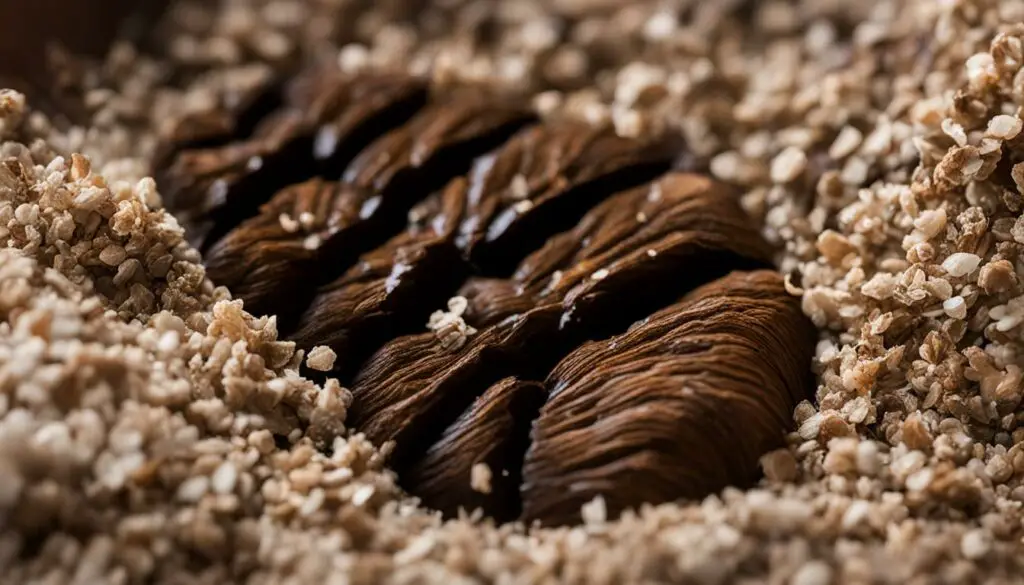
Walnut cat litter offers a range of benefits that make it a popular choice among cat owners. One of the key advantages is its lightweight nature, which makes it easy to handle and transport. Whether you opt for the clumping or non-clumping variety, walnut litter is known for its low dust content, providing a cleaner litter box environment for both you and your feline friend.
In terms of odor control, walnut cat litter performs decently, helping to neutralize odors and keep your home smelling fresh. The eco-friendly nature of walnut litter is another noteworthy benefit. Made from biodegradable materials, it is a much more sustainable option compared to clay litter, reducing its impact on the environment.
Furthermore, walnut cat litter is non-toxic and safe for your cat to use. However, it’s important to note that walnut litter can track due to its small particle size, and its dark color can make it somewhat challenging to scoop out solid waste from the litter box. Additionally, if not stored properly, walnut litter can be vulnerable to spoilage, so it’s essential to follow the manufacturer’s guidelines for storage.
| Pros of Walnut Cat Litter |
|---|
| Lightweight |
| Clumping and non-clumping varieties available |
| Low dust |
| Decent odor control |
| Eco-friendly and biodegradable |
| Non-toxic |
| Can track |
| Dark color makes it harder to scoop out solids |
| Vulnerable to spoilage |
“Walnut cat litter offers a lightweight and eco-friendly alternative to traditional clay litter. It provides decent odor control and is safe for your cat, but be aware of the potential challenges it may present in terms of tracking and scooping.”
Pros of Pine Pellet Cat Litter
Pine pellet cat litter offers several benefits that make it a popular choice among cat owners. One of its main advantages is its good odor control. The natural pine scent of the litter helps to neutralize unpleasant smells, keeping your home fresh and clean. Additionally, pine pellet litter produces low dust, making it a healthier option for both cats and their owners. The reduced dust also means less mess and easier cleanup.
Another significant benefit of pine pellet litter is its eco-friendliness. Made from renewable pine wood, this litter is biodegradable and sustainable. It is an excellent choice for environmentally conscious individuals who want to reduce their carbon footprint. Additionally, pine pellet litter is non-toxic, ensuring the safety and well-being of your furry friend.
One of the most appealing aspects of pine pellet litter is its affordability. It is a highly cost-effective option compared to other types of cat litter. Despite its low price, pine pellet litter still offers excellent performance in terms of odor control and absorbency. This makes it a budget-friendly choice for cat owners looking for a quality litter that won’t break the bank.
While pine pellet litter has many advantages, it’s important to note that some cats may find the texture uncomfortable. Cats with sensitive paws may prefer a softer litter option. Additionally, pine pellet litter is non-clumping, which means it can be more challenging to clean compared to clumping litters. However, with regular maintenance and proper litter box hygiene, pine pellet litter can still provide a clean and comfortable environment for your cat.
| Pros of Pine Pellet Cat Litter |
|---|
| Good odor control |
| Low dust |
| Eco-friendly |
| Non-toxic |
| Very affordable |
| Low tracking |
| Uncomfortable texture for some cats |
| Natural pine scent |
| Difficult to clean |
| Non-clumping |
Pros of Corn Cat Litter
Corn cat litter offers a variety of benefits that make it a popular choice among cat owners. First and foremost, corn litter is eco-friendly and non-toxic, making it safe for both cats and the environment. It is made from natural corn kernels and does not contain any harmful chemicals or additives. This makes it a great option for cat owners who prioritize sustainability and their pet’s health.
One of the standout features of corn cat litter is its paw-friendly texture. The litter is soft and gentle, providing a comfortable experience for cats as they dig and cover their waste. Many cats find the texture of corn litter more appealing compared to other types of litter, increasing their acceptance and usage of the litter box.
Additionally, corn cat litter is biodegradable and flushable. This means that it can be easily disposed of without causing harm to the environment. Cat owners can simply flush the used litter down the toilet, eliminating the need for scooping and bagging waste. This convenience factor makes corn litter a popular choice for busy pet owners.
Corn litter also offers decent odor control, low dust levels, and clumping abilities. It effectively absorbs and neutralizes odors, keeping the litter box smelling fresh. The low dust formula reduces tracking and helps maintain a clean living space. Moreover, corn litter forms firm clumps when in contact with liquids, making it easy to scoop and remove waste.
However, it is important to note that corn cat litter can be vulnerable to spoilage if not stored properly. Moisture and humidity can cause the litter to become moldy or attract insects. To prevent spoilage, it is recommended to store corn litter in a dry and well-sealed container.
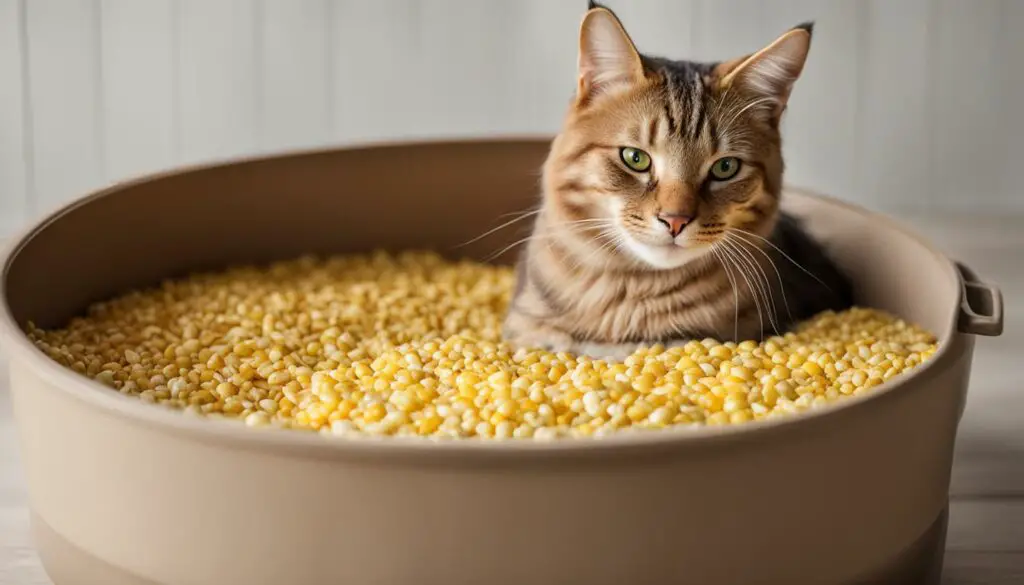
Overall, corn cat litter offers a range of benefits including its eco-friendly and non-toxic nature, paw-friendly texture, biodegradability, flushability, decent odor control, low dust levels, and clumping abilities. Cat owners who prioritize sustainability, their pet’s health, and convenience often find that corn litter is an excellent choice for their furry friends.
Best Cat Litter Overall: Tofu Cat Litter
After considering the pros and cons of various cat litters, I have determined that tofu cat litter is the best option overall. Tofu litter offers a range of benefits and features that make it a top choice for cat owners looking for a natural, effective, and environmentally friendly litter option.
Tofu cat litter is natural and made from soybean residue, making it a sustainable and eco-friendly choice. It is also biodegradable and flushable, ensuring easy disposal without harming the environment. The litter is clumping, which makes it easy to clean and maintain a clean litter box. It is highly absorbent and effectively controls odors, keeping your home smelling fresh.
One of the standout features of tofu cat litter is its non-tracking nature. The litter particles are lightweight and have a low tendency to stick to your cat’s paws, reducing the mess and tracking outside the litter box. Additionally, tofu litter is virtually dust-free, creating a cleaner and healthier environment for both cats and their owners.
| Features | Benefits |
|---|---|
| Natural and eco-friendly | Reduces environmental impact |
| Flushable | Easy and convenient disposal |
| Clumping | Easier cleaning and maintenance |
| Absorbent | Controls odors effectively |
| Non-tracking | Reduces mess outside the litter box |
| Lightweight | Easier handling and pouring |
| Dust-free | Cleaner and healthier environment |
| Long-lasting | Value for money |
With its numerous benefits and features, tofu cat litter provides a comprehensive solution for litter box cleanliness and odor control. It is a safe and effective choice for both cats and their owners, promoting a hygienic and comfortable litter box environment. Consider making the switch to tofu cat litter to provide your furry friend with the best litter experience.
Tofu Cat Litter at Tuft + Paw
Tuft + Paw offers a premium tofu cat litter that prioritizes the safety, health, and well-being of cats. Made from eco-friendly, biodegradable materials, this litter is a sustainable choice for both the environment and your furry friend. It is flushable, allowing for easy disposal, and provides long-lasting performance to keep your litter box fresh and clean.
One of the key benefits of Tuft + Paw’s tofu cat litter is its dust-free composition. This means that you and your cat can breathe easy, as there won’t be any irritating particles in the air when using the litter. Additionally, the low tracking feature helps minimize mess around the litter box area, keeping your home cleaner and more hygienic.
This tofu litter is clumping, making it convenient for scooping out waste and ensuring that the litter box stays clean and odor-free. It is also non-toxic, lightweight, and gentle on your cat’s paws, providing them with a comfortable experience during their bathroom routine.
It’s important to note that premium quality tofu litter may come with a slightly higher price tag compared to some other options. Additionally, storing tofu litter in a dry environment is crucial to prevent spoilage. By choosing Tuft + Paw’s tofu cat litter, you not only prioritize your cat’s health and safety but also contribute to a more sustainable and eco-friendly lifestyle.
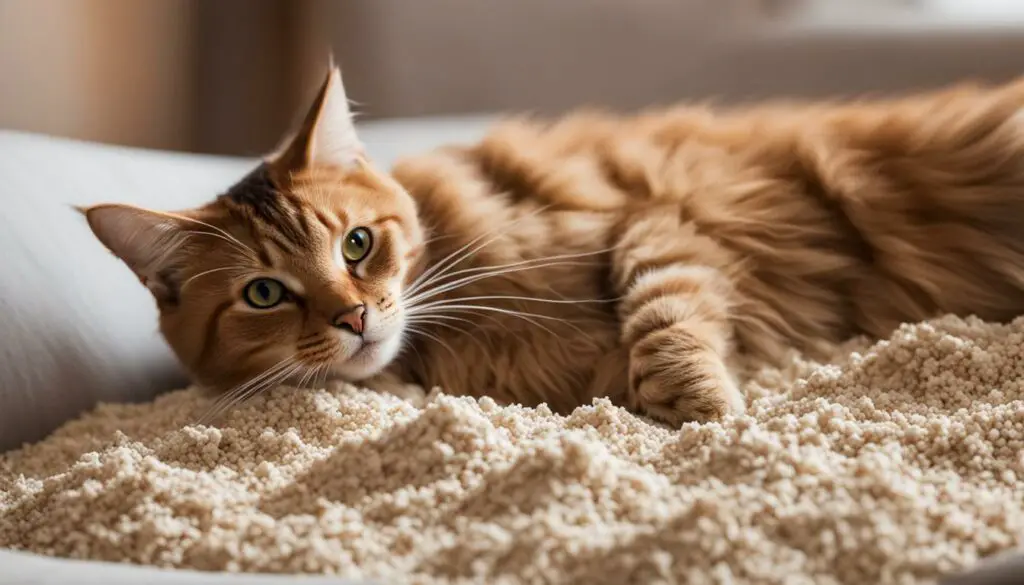
| Benefits | Features |
|---|---|
| Safety | – Non-toxic |
| Health | – Dust-free |
| Eco-friendly | – Biodegradable |
| Convenience | – Flushable |
| Long-lasting | – Clumping |
| Low Tracking | – Lightweight |
Tips for Transitioning to Tofu Cat Litter
Transitioning your cat to tofu cat litter can be a smooth process with the right approach. Here are some tips to help you make the switch:
- Consider your cat’s preferences: Every cat is unique, so it’s important to take your cat’s preferences into account. Some cats may adapt quickly to the new litter, while others may need more time and patience to adjust.
- Start with a slow transition: Begin by mixing a small amount of tofu litter with your cat’s current litter. Gradually increase the ratio of tofu litter over time. This gradual transition will allow your cat to become familiar with the new litter without feeling overwhelmed.
- Choose the right litter box location: Keep the litter box in the same location during the transition. Cats are creatures of habit, and changing the location of the litter box can confuse them.
- Maintain litter box hygiene: Ensure that the litter box is clean and free from any lingering odors. Cats are more likely to use a clean litter box, so regular maintenance is essential.
- Monitor litter box habits: Pay attention to your cat’s litter box habits during the transition. If your cat is showing signs of discomfort or refusal to use the litter box, consider adjusting the transition process or consulting with a veterinarian.
Remember, transitioning to tofu cat litter requires patience and understanding. With these tips and a little time, your cat can successfully switch to the new litter and enjoy a healthier and more environmentally friendly option.
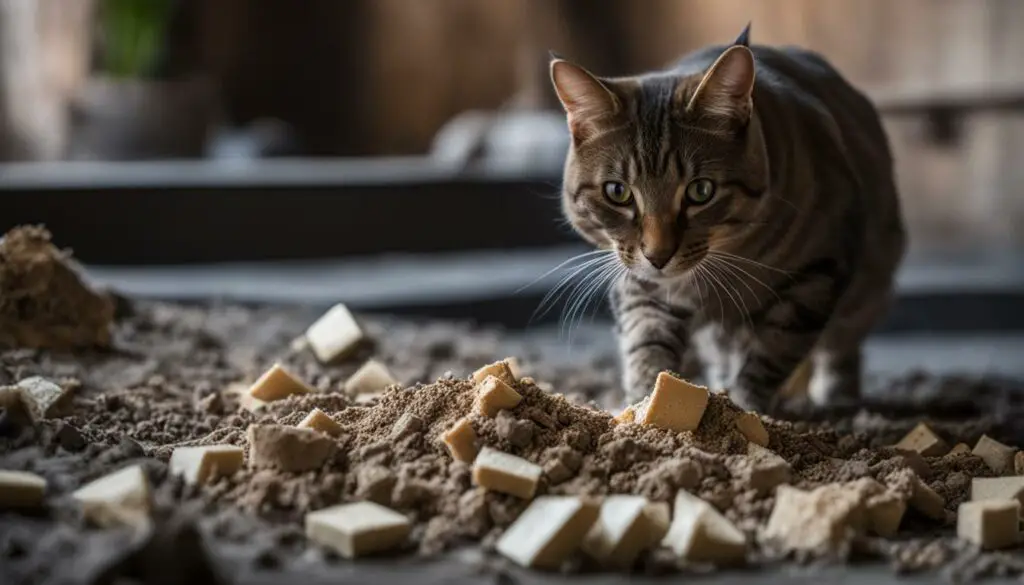
Example of Litter Box Training Techniques
For some cats, litter box training may be necessary, especially if they are not familiar with using a litter box. Here are a few litter box training techniques that can help:
- Choose the right litter box: Ensure that the litter box is large enough for your cat to comfortably move around and dig. Consider using a litter box with low sides for easy access.
- Show your cat the litter box: Place your cat in the litter box and gently scratch the litter with your finger to demonstrate its purpose. Encourage your cat to sniff and explore the litter box.
- Provide positive reinforcement: When your cat uses the litter box correctly, praise and reward them with treats or verbal praise. Positive reinforcement can help reinforce the desired behavior.
- Be consistent: Set a regular schedule for litter box use and stick to it. Cats thrive on routine, so maintaining a consistent schedule can help establish good litter box habits.
- Address accidents appropriately: If your cat has accidents outside the litter box, clean the area thoroughly and avoid punishing your cat. Punishment can create fear and anxiety, making litter box training more challenging.
Remember to be patient and consistent with your training efforts. With time and positive reinforcement, most cats can learn to use the litter box reliably.
Conclusion
After a comprehensive exploration of the pros and cons of clay litter and tofu litter, it is clear that tofu cat litter is a better choice for the health of your cat and the environment. Clay litter, although affordable and readily available, comes with various drawbacks such as tracking, dustiness, and its heavy composition. More importantly, it contains carcinogenic silica dust, which can pose a risk to both cats and humans. On the other hand, tofu cat litter offers numerous benefits, including being eco-friendly, biodegradable, flushable, and long-lasting. It is also dust-free and provides excellent odor control.
Transitioning to tofu cat litter may require some patience and adjustment for your cat, but the benefits are well worth it. By making the switch, you can ensure a healthier and safer litter box environment for your feline friend. Additionally, choosing tofu cat litter is a more environmentally friendly choice, as it reduces the carbon footprint and minimizes waste. With its natural composition and ease of use, tofu cat litter is a superior option for cat owners who prioritize their cat’s health and the impact on the planet.
So, say goodbye to clay litter and embrace the benefits of tofu cat litter. Your cat will appreciate the comfortable and safe litter box experience, and you can feel good about making a positive impact on the environment. Make the switch today and see the difference it can make in your cat’s health and overall well-being.
FAQ
Is clay litter bad for cats?
Clay litter has some downsides, including being prone to tracking, dusty, heavy, and containing carcinogenic silica dust. It may not be the best choice for cats due to potential health risks and its environmental impact.
What are the pros of non-clumping clay litter?
Non-clumping clay litter is affordable, readily available, and requires less scooping. However, it can be dusty, easily tracked, and offers mediocre odor control. It is also heavy, not eco-friendly, and contains carcinogenic silica dust.
What are the cons of non-clumping clay litter?
The cons of non-clumping clay litter include its affordability and wide availability. It requires less scooping compared to other litter types. However, it can be dusty, easily tracked, and offers mediocre odor control. Non-clumping clay litter is heavy and not environmentally friendly as it does not biodegrade. Most importantly, it contains carcinogenic silica dust, which poses a risk to the health of both cats and humans.
What are the pros of clumping clay litter?
Clumping clay litter is easier to clean, offers better odor control, and lasts longer compared to non-clumping litter. However, it can be dusty, easily tracked, and is not environmentally friendly. Like non-clumping clay litter, it also contains carcinogenic silica dust, which can be harmful when inhaled.
What are the cons of clumping clay litter?
The disadvantages of clumping clay litter include its ease of cleaning and better odor control. It also lasts longer compared to non-clumping litter. However, it can be dusty, easily tracked, and is not environmentally friendly. Like non-clumping clay litter, clumping clay litter is heavy and does not biodegrade. The presence of carcinogenic silica dust is also a concern for the health of both cats and humans.
What are the pros of tofu cat litter?
Tofu cat litter is eco-friendly, biodegradable, flushable, long-lasting, dust-free, and has low tracking. It clumps well, is non-toxic, lightweight, and provides excellent odor control. It is a safe option for both cats and humans.
What are the cons of tofu cat litter?
The cons of tofu cat litter include its higher price compared to other options and vulnerability to spoilage if not stored properly. Some cats may not prefer the texture or scent of tofu litter. However, overall, tofu cat litter is a safe and environmentally friendly option for cat owners.
What are the pros of crystal (silica gel) cat litter?
Crystal cat litter produces low dust, is lightweight, provides great odor control, and keeps the litter box hygienic. It requires low maintenance, is non-toxic, and reduces the growth of mold and bacteria. However, it can be easily tracked and has an uncomfortable texture for sensitive paws. It does not clump and is not environmentally friendly.
What are the pros of paper pellet cat litter?
Paper pellet cat litter is eco-friendly, biodegradable, low tracking, and produces low dust. It is affordable, unscented, and non-toxic. However, it may have an uncomfortable texture for some cats and can be difficult to clean. It does not clump and requires more frequent changing compared to clumping litters.
What are the pros of walnut cat litter?
Walnut cat litter is lightweight, has low dust, and provides decent odor control. It is eco-friendly, biodegradable, and non-toxic. However, the dark color of walnut litter can make it harder to scoop out solid waste. It may also be vulnerable to spoilage if not stored properly.
What are the pros of pine pellet cat litter?
Pine pellet cat litter provides good odor control, produces low dust, and is eco-friendly and non-toxic. It is also very affordable and has low tracking. However, the texture of pine pellets may be uncomfortable for some cats. It can be difficult to clean and does not clump.
What are the pros of corn cat litter?
Corn cat litter is eco-friendly, non-toxic, and has a paw-friendly texture. It is biodegradable, flushable, and provides decent odor control. It produces low dust, clumps well, and is affordable. However, it can be vulnerable to spoilage if not stored properly and may be easily tracked. It has an earthy smell that some people may not prefer.
What is the best cat litter overall?
Tofu cat litter is considered the best overall choice. It is natural, flushable, clumping, absorbent, non-tracking, lightweight, dust-free, and provides long-lasting odor control. It is a safe and environmentally friendly option for cat owners.
What is tofu cat litter at Tuft + Paw?
Tuft + Paw offers tofu cat litter specially formulated to meet the needs of cats. Their tofu litter is eco-friendly, biodegradable, flushable, and long-lasting. It is dust-free with low tracking and clumps well. However, premium quality tofu litter may have a higher price compared to other options and can be vulnerable to spoilage if not stored properly.
What are tips for transitioning to tofu cat litter?
When transitioning to tofu cat litter, it is important to do so slowly and consider your cat’s preferences. Start by mixing the new litter with your cat’s current litter and gradually increase the ratio of tofu litter over time. Keep the litter box in the same location and maintain good litter box hygiene. Monitor your cat’s litter box habits and make any necessary adjustments. Patience and positive reinforcement are key to a successful transition.
Is clay litter bad for cats?
After considering the pros and cons of various cat litters, clay litter may not be the best choice for cats due to its potential health risks and environmental impact. Tofu cat litter offers a safer and more environmentally friendly option for cat owners.

